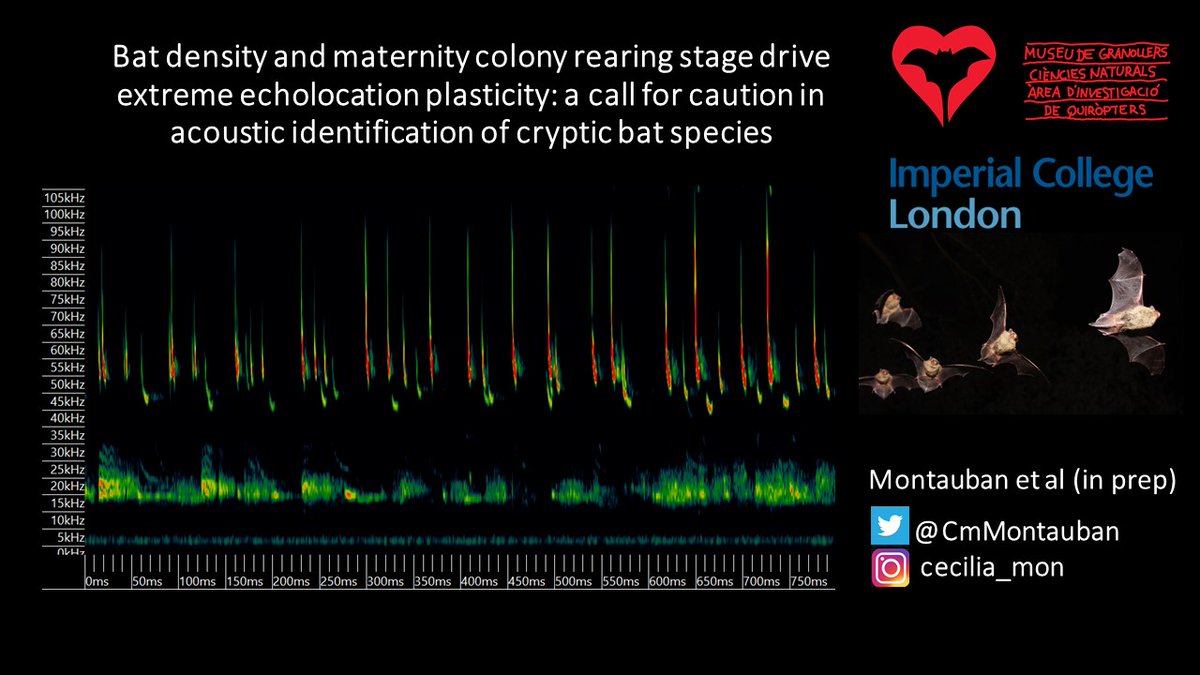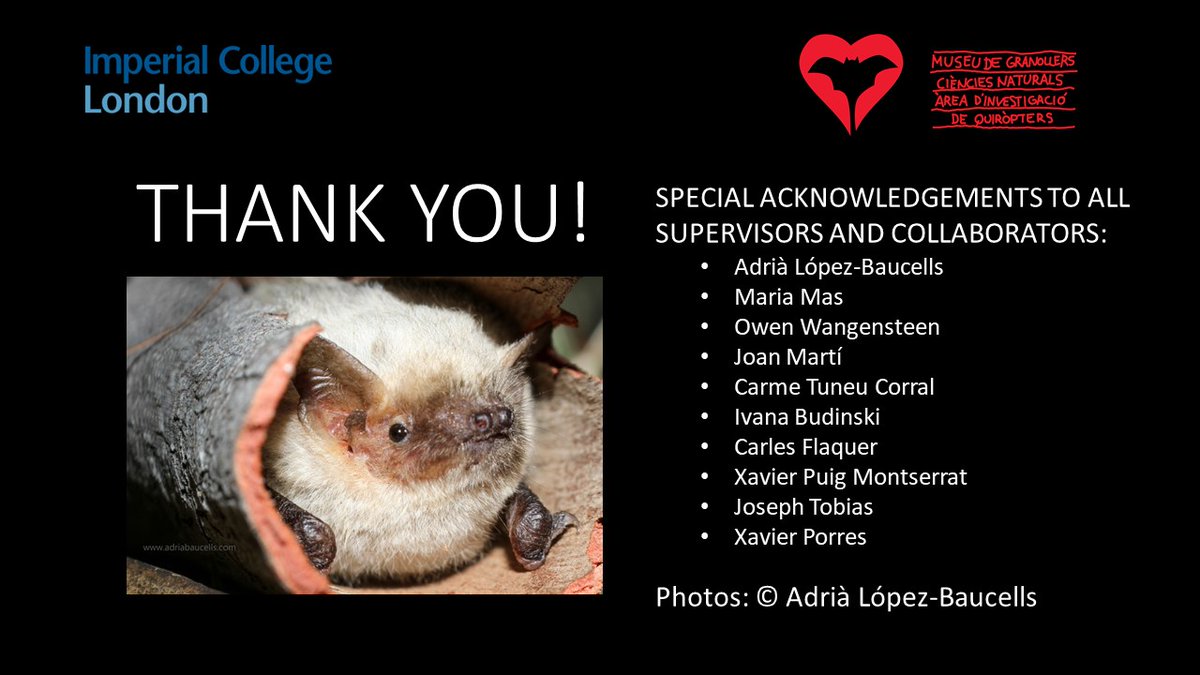1. #WBTC1 #EvoBeh2 Bat #acoustic monitoring is fantastic and has led to species discoveries worldwide. But often we are faced with trying to classify #sonograms that look like this  https://abs.twimg.com/emoji/v2/... draggable="false" alt="⬇️" title="Downwards arrow" aria-label="Emoji: Downwards arrow">. Can you guess what common widespread European species are recorded here?
https://abs.twimg.com/emoji/v2/... draggable="false" alt="⬇️" title="Downwards arrow" aria-label="Emoji: Downwards arrow">. Can you guess what common widespread European species are recorded here?  https://abs.twimg.com/emoji/v2/... draggable="false" alt="🦇" title="Bat" aria-label="Emoji: Bat"> #echolocation
https://abs.twimg.com/emoji/v2/... draggable="false" alt="🦇" title="Bat" aria-label="Emoji: Bat"> #echolocation
2. #WBTC1 #EvoBeh2 Echolocation keys point to 2 cryptic species here.
But is it that simple? https://abs.twimg.com/emoji/v2/... draggable="false" alt="🤷♀️" title="Woman shrugging" aria-label="Emoji: Woman shrugging">
https://abs.twimg.com/emoji/v2/... draggable="false" alt="🤷♀️" title="Woman shrugging" aria-label="Emoji: Woman shrugging">
Why is it that in 20 years of extensive bat monitoring in #EbroDelta acoustic surveys suggest presence of both pipistrelles, yet Ppip has never been confirmed? https://abs.twimg.com/emoji/v2/... draggable="false" alt="⁉️" title="Exclamation question mark" aria-label="Emoji: Exclamation question mark">
https://abs.twimg.com/emoji/v2/... draggable="false" alt="⁉️" title="Exclamation question mark" aria-label="Emoji: Exclamation question mark"> https://abs.twimg.com/emoji/v2/... draggable="false" alt="🤔" title="Thinking face" aria-label="Emoji: Thinking face">
https://abs.twimg.com/emoji/v2/... draggable="false" alt="🤔" title="Thinking face" aria-label="Emoji: Thinking face">
But is it that simple?
Why is it that in 20 years of extensive bat monitoring in #EbroDelta acoustic surveys suggest presence of both pipistrelles, yet Ppip has never been confirmed?
3. #WBTC1 #EvoBeh2! We used DNA high-throughput barcoding  https://abs.twimg.com/emoji/v2/... draggable="false" alt="🧬" title="DNA" aria-label="Emoji: DNA">, intensive trapping, roost checks (of 400+ #batboxes and buildings), emergence surveys & passive detectors across the delta to test who was emitting the lower freq calls?
https://abs.twimg.com/emoji/v2/... draggable="false" alt="🧬" title="DNA" aria-label="Emoji: DNA">, intensive trapping, roost checks (of 400+ #batboxes and buildings), emergence surveys & passive detectors across the delta to test who was emitting the lower freq calls? https://abs.twimg.com/emoji/v2/... draggable="false" alt="📢" title="Public address loudspeaker" aria-label="Emoji: Public address loudspeaker"> a) Pppip or b) Ppyg w/ echolocation plasticity
https://abs.twimg.com/emoji/v2/... draggable="false" alt="📢" title="Public address loudspeaker" aria-label="Emoji: Public address loudspeaker"> a) Pppip or b) Ppyg w/ echolocation plasticity
4. #WBTC1 #EvoBeh2 There were all Ppyg! Emerging Ppyg (confirmed by  https://abs.twimg.com/emoji/v2/... draggable="false" alt="🧬" title="DNA" aria-label="Emoji: DNA">) echolocated with FME as low as 44kHz (lower than ever reported
https://abs.twimg.com/emoji/v2/... draggable="false" alt="🧬" title="DNA" aria-label="Emoji: DNA">) echolocated with FME as low as 44kHz (lower than ever reported  https://abs.twimg.com/emoji/v2/... draggable="false" alt="‼️" title="Double exclamation mark" aria-label="Emoji: Double exclamation mark">), w/ 29% of calls in the FME range of Ppip
https://abs.twimg.com/emoji/v2/... draggable="false" alt="‼️" title="Double exclamation mark" aria-label="Emoji: Double exclamation mark">), w/ 29% of calls in the FME range of Ppip  https://abs.twimg.com/emoji/v2/... draggable="false" alt="🧐" title="Face with monocle" aria-label="Emoji: Face with monocle">! 3 variables significantly affected FME plasticity: habitat, bat density, and bat rearing stage
https://abs.twimg.com/emoji/v2/... draggable="false" alt="🧐" title="Face with monocle" aria-label="Emoji: Face with monocle">! 3 variables significantly affected FME plasticity: habitat, bat density, and bat rearing stage
5. #WBTC1 #EvoBeh2 Takeaway  https://abs.twimg.com/emoji/v2/... draggable="false" alt="✉️" title="Envelope" aria-label="Emoji: Envelope">: ID classification can fail to account for echolocation plasticity. We add to a growing list of literature highlighting the behavioural and ecological extents of this #plasticity – with important implications for bat monitoring efforts. More soon
https://abs.twimg.com/emoji/v2/... draggable="false" alt="✉️" title="Envelope" aria-label="Emoji: Envelope">: ID classification can fail to account for echolocation plasticity. We add to a growing list of literature highlighting the behavioural and ecological extents of this #plasticity – with important implications for bat monitoring efforts. More soon  https://abs.twimg.com/emoji/v2/... draggable="false" alt="🤞" title="Crossed fingers" aria-label="Emoji: Crossed fingers">
https://abs.twimg.com/emoji/v2/... draggable="false" alt="🤞" title="Crossed fingers" aria-label="Emoji: Crossed fingers">

 Read on Twitter
Read on Twitter . Can you guess what common widespread European species are recorded here? https://abs.twimg.com/emoji/v2/... draggable="false" alt="🦇" title="Bat" aria-label="Emoji: Bat"> #echolocation" title="1. #WBTC1 #EvoBeh2 Bat #acoustic monitoring is fantastic and has led to species discoveries worldwide. But often we are faced with trying to classify #sonograms that look like this https://abs.twimg.com/emoji/v2/... draggable="false" alt="⬇️" title="Downwards arrow" aria-label="Emoji: Downwards arrow">. Can you guess what common widespread European species are recorded here? https://abs.twimg.com/emoji/v2/... draggable="false" alt="🦇" title="Bat" aria-label="Emoji: Bat"> #echolocation" class="img-responsive" style="max-width:100%;"/>
. Can you guess what common widespread European species are recorded here? https://abs.twimg.com/emoji/v2/... draggable="false" alt="🦇" title="Bat" aria-label="Emoji: Bat"> #echolocation" title="1. #WBTC1 #EvoBeh2 Bat #acoustic monitoring is fantastic and has led to species discoveries worldwide. But often we are faced with trying to classify #sonograms that look like this https://abs.twimg.com/emoji/v2/... draggable="false" alt="⬇️" title="Downwards arrow" aria-label="Emoji: Downwards arrow">. Can you guess what common widespread European species are recorded here? https://abs.twimg.com/emoji/v2/... draggable="false" alt="🦇" title="Bat" aria-label="Emoji: Bat"> #echolocation" class="img-responsive" style="max-width:100%;"/>
 : ID classification can fail to account for echolocation plasticity. We add to a growing list of literature highlighting the behavioural and ecological extents of this #plasticity – with important implications for bat monitoring efforts. More soon https://abs.twimg.com/emoji/v2/... draggable="false" alt="🤞" title="Crossed fingers" aria-label="Emoji: Crossed fingers">" title="5. #WBTC1 #EvoBeh2 Takeaway https://abs.twimg.com/emoji/v2/... draggable="false" alt="✉️" title="Envelope" aria-label="Emoji: Envelope">: ID classification can fail to account for echolocation plasticity. We add to a growing list of literature highlighting the behavioural and ecological extents of this #plasticity – with important implications for bat monitoring efforts. More soon https://abs.twimg.com/emoji/v2/... draggable="false" alt="🤞" title="Crossed fingers" aria-label="Emoji: Crossed fingers">" class="img-responsive" style="max-width:100%;"/>
: ID classification can fail to account for echolocation plasticity. We add to a growing list of literature highlighting the behavioural and ecological extents of this #plasticity – with important implications for bat monitoring efforts. More soon https://abs.twimg.com/emoji/v2/... draggable="false" alt="🤞" title="Crossed fingers" aria-label="Emoji: Crossed fingers">" title="5. #WBTC1 #EvoBeh2 Takeaway https://abs.twimg.com/emoji/v2/... draggable="false" alt="✉️" title="Envelope" aria-label="Emoji: Envelope">: ID classification can fail to account for echolocation plasticity. We add to a growing list of literature highlighting the behavioural and ecological extents of this #plasticity – with important implications for bat monitoring efforts. More soon https://abs.twimg.com/emoji/v2/... draggable="false" alt="🤞" title="Crossed fingers" aria-label="Emoji: Crossed fingers">" class="img-responsive" style="max-width:100%;"/>


